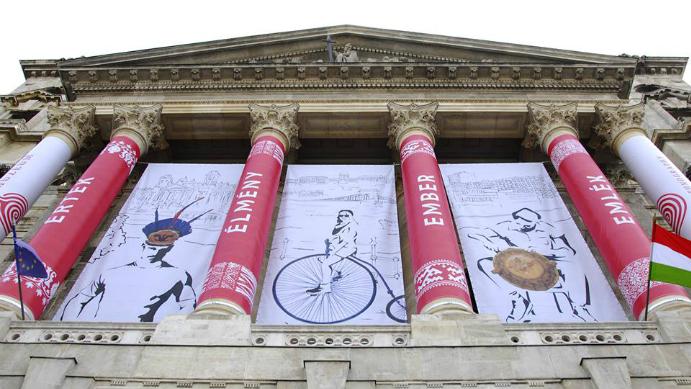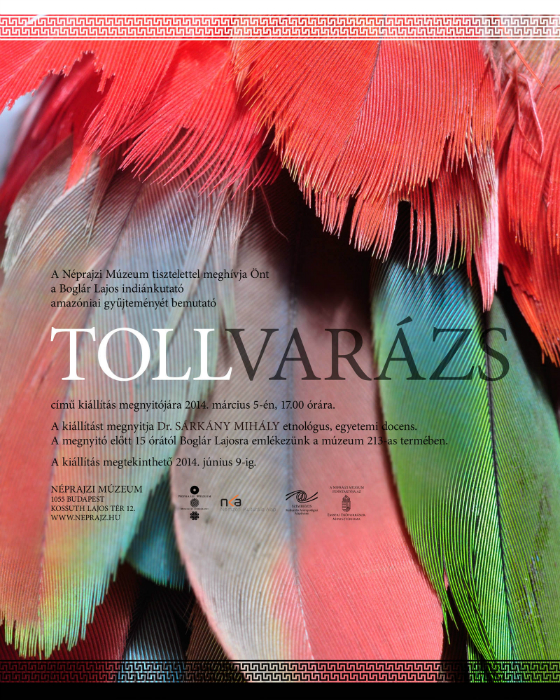New clothes for the museum
NEW STYLE
In early March the Museum of Ethnography in Budapest launched its communication campaign. We have gone to find out about the new strategy, the hows and the whys.
| Hermann Veronika |
2014-03-23 22:25 |
Why did the museum decide to reposition itself just when it was announced that finally the Museum of Ethnography was going to leave its present location which is in the heart of the city opposite the parliament?
We can not talk about a comprehensive shift in our image says György Szeljak, a cultural anthropologist of the museum, and now the newly appointed Head of Communications. These are changes taking place continuously and they are being mediated now in this campaign, which started on the 5 March and will end in late June. The launch date is very important for us: this is the Day of the Museum, actually the anniversary of its foundation. We invite guests and the press every year on this day and tell them about our previous year and the plans for the next one. We also have an award ceremony on this day, to mark and celebrate great achievements in our field. And as for the financial means: I also have to mention that now we received extra resources from the National Cultural Fund to implement this campaign.
During the campaign we are going to open three new and very important exhibitions, which are designed to highlight our traditions as well as our modern, contemporary approach. The exhibition called Charming Feathers has already opened and it displays the museum’s unique collection of Indian feathers from the Amazonas region. The second one, from April, is named Bicyclecity and will illustrate how historical past, contemporary urban culture and identity are interconnected. The third one, due to open in June, is entitled Contempt and Self-esteem, and focuses on travelling tradesmen and their adventurous life. We hope this one to be something really thought-provoking. The first exhibition represents the museum’s international scope, the second one its keen interest in contemporary culture and the third one its capacity in traditional ethnography.

Your communication is based on four words: value, experience, people and memory. Apart from the fact that they beautifully alliterate in Hungarian, why did you build the campaign around these four?
One of our biggest problems was visibility. The questions were: how can the Museum of Ethnography become visible in the social space as well as for the audience that consumes culture in Budapest today? How can it position itself in the governmental district of the capital, surrounded by ministries, governmental offices and the parliament itself. In fact, we are right opposite the parliament building and between us there is the newly renovated Kossuth square, which will obviously attract a lot of visitors. These buildings and the square itself are extremely rich in symbolic content, and that is what makes it very important for us to be visible. We chose to work with a communication agency called Style Communications to find out the new clothes, if you want, the new packaging of the museum. We wanted to create something unusual, youthful and playful, so we had to take some risk. We opted for solutions which grab the attention of the people coming to this square and are meaningful for young people too. In terms of content we did build on our new mission statement, which defines the museum as a social museum and an open space.
 A space in which people belonging to different ethnic-, age- and social groups can meet, where different values encounter. With the campaign we intend to initiate a discourse about what it means to be a social museum today. Looking at it from outside, our building has six columns, two of which now feature the name of the museum in English and in Hungarian. On the other four, we displayed words which are very common and easy to understand, and which, despite their simplicity, carry important messages. We could have, of course, placed even ten such words on these columns, but we had decided to start the communication with these four. These words are very important for us too: they can show how we, the people who work here, see this museum.
A space in which people belonging to different ethnic-, age- and social groups can meet, where different values encounter. With the campaign we intend to initiate a discourse about what it means to be a social museum today. Looking at it from outside, our building has six columns, two of which now feature the name of the museum in English and in Hungarian. On the other four, we displayed words which are very common and easy to understand, and which, despite their simplicity, carry important messages. We could have, of course, placed even ten such words on these columns, but we had decided to start the communication with these four. These words are very important for us too: they can show how we, the people who work here, see this museum.
What other elements does the campaign have?
We have been present in several media segments. A radio spot will be broadcast on national stations, every exhibition will have a microsite to supplement the information available on our main website, which, lets face it, has become somewhat obsolete by now. We are going to devise an internal information system which will help the visitors inside the physical space of our large, old and complex building.
Now when resources are getting scarce for museums, what strategies do you see for these institutions to share their professional achievements with the wider public?
Social media is becoming crucial now. It is also very important to be present outside the walls of the museum. It is vital today to cooperate with NGOs and foundations and with any other institutions whose activities are relevant to what we are doing here. This will also help to further the idea of the open museum.
When will you call this a successful campaign?
Well, I would call it a success if even more people began to like and pay attention to the Museum of Ethnography. If our visitors did not come here as if they were coming to the sacred temple of science where truth is revealed for them, but if they came here to be part of an open cultural space where they could think and talk freely with each other and with us.
Photo: Sarnyai Krisztina